by Jessica Giles | February 2, 2021
The Great Mow Show: Inside the World of Lawn Mower Racing
In pursuit of speed and glory, NASGRASS drivers of all ages race to keep the sport alive in Avon Park.
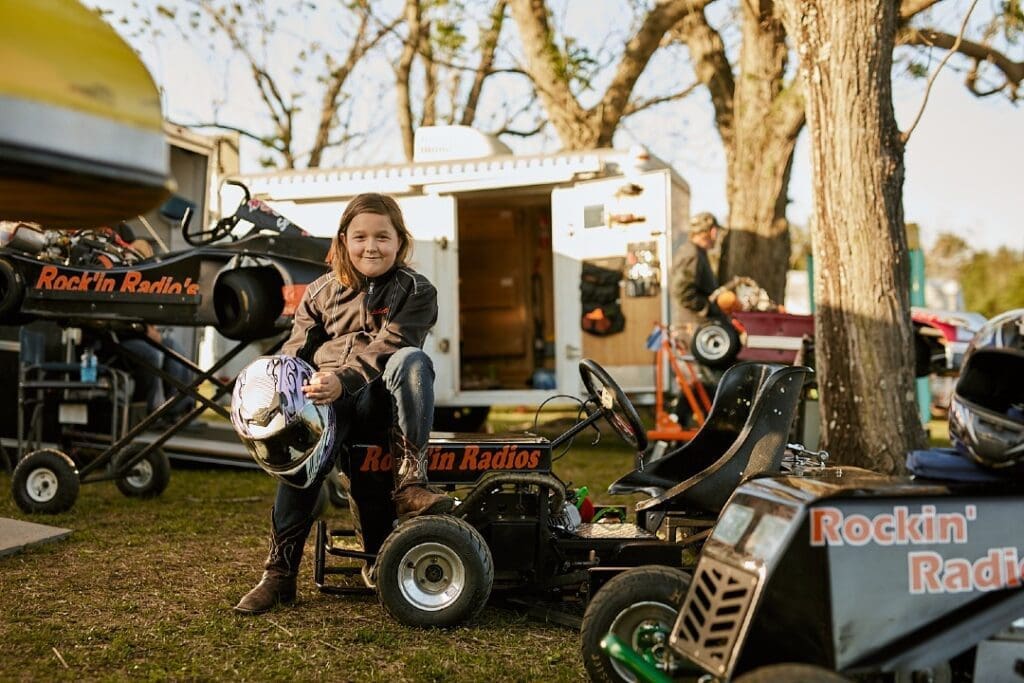
Brian Wallace doesn’t tell the whole story right off the bat; he likes to let people assume. When the 50-year-old father of two from Sarasota explains to folks that his family is headed to a race this weekend, they think of the usual: go-karts, remote-controlled cars, motocross. They never guess lawn mowers. A standard reaction always follows their realization: “You race what?” head cocked sideways, sure they misheard Wallace the first time.
Telling people you race lawn mowers comes with a certain stigma. The mind automatically envisions something out of a Jackass movie: tattooed rednecks souping up and flipping over mowers for fun. To be sure, you’ll find your fair share of cowboy boots, camo jackets and mullets that would put Billy Ray Cyrus to shame, but the racing itself is anything but reckless.
The Wallace family has been racing lawn mowers for about seven years, although Brian’s never taken one for a spin himself. He’s the family mechanic and crew chief, responsible for building and maintaining the machines that his wife, Stacy, and two sons, Reed and Riley, race. Over the years, his 13-year-old son has earned the nickname “Wreck ‘Em Reed,” so Brian assures me that his mechanic duties keep him much too busy to race himself.

On this frigid first weekend of January, the Wallace family is huddled around their portable fire pit in the parking lot of the racetrack. It started with a small, enclosed trailer that they’d use to haul a lawn mower or two up to the races in Avon Park, just north of Sebring, on the first weekend of each month. Then they graduated to a pull-behind camper, then a fifth-wheel trailer and now, a state-of-the-art RV.
A motley crew of vehicles, from rusted pickup trucks pulling wooden trailers one screw away from coming undone to luxury RVs like the ones seen parked at Disney World, fill the driver’s pit. It’s an unconventional sport, to say the least, but it breeds the same sort of camaraderie and competition found on a traditional track. Everyone from 8-year-olds bored with Razor scooters to 80-year-olds still satiating their need for speed find bliss atop a rigged riding mower. For some, affordability is the allure. For others, it’s the thrill of open-wheel racing on a clay track with a machine never designed to fly around hairpin turns. Still others suit up to carry on their family’s long legacy of racing—even if it’s in a way that might raise eyebrows.
“We Were Dead Broke”
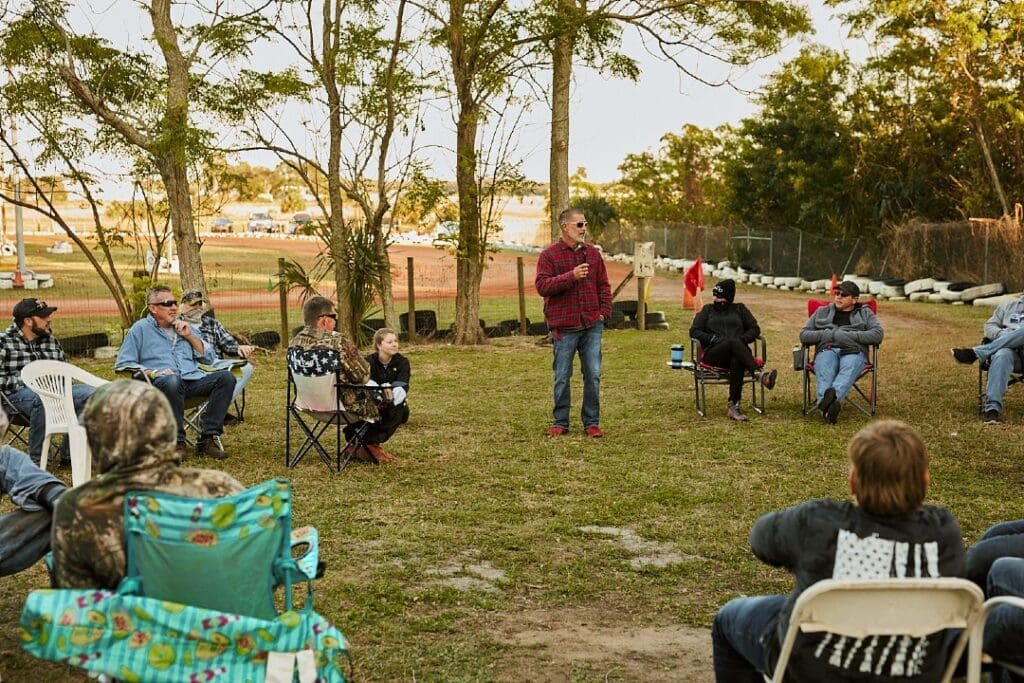
Despite being the first for-purpose lawn mower racing facility in the nation, the Avon Park Mower-Plex isn’t exactly the Daytona International Speedway of the sport. Two sets of wooden bleachers overlook a humble 720-foot clay track enclosed with a chain-link fence. In the driver’s pit, picnic benches bear slogans like “The Great Mow Show” and the “Race is on” in faded white paint. Although previously affiliated with the United States Lawn Mower Racing Association, now the track is overseen by the North American Society of Grass Racers and Sod Slingers, or NASGRASS for short.
Hours before the green flag waves for the first race of 2021, drivers hustle around the pit making last-minute adjustments and prepping the track. Before each race, NASGRASS President Wes Pyburn scribbles out a list of chores and tools needed for the weekend on a dry erase board and shares it on Facebook. Without fail, members show up early to fix bleachers, change lightbulbs and replace jump starters, knocking out Pyburn’s to-do list before the first spectator arrives.
Today, the traditionally mild Florida weather is rioting. It’s so cold Pyburn is convinced it has scared away the South Floridians who usually drive up to race. Even still, the pit buzzes and revs with the sound of souped up mowers, kids chasing stray tires and bonfires crackling. As the sun sets over the clay track, and the temperature kisses 40 degrees, the racers circle up for the mandatory driver’s meeting.
“Y’all ready to freeze your butts off?” Pyburn chides. The chorus lets out a grumble, hands stuffed into hoodies and buffs pulled up over their faces, too cold to enunciate any real words. A chihuahua sporting a sweater and tucked into the camo jacket of one of the racers shivers. Pyburn dives into a slew of housekeeping about maintenance at the track, mowers for sale and the looming national championship race in March.
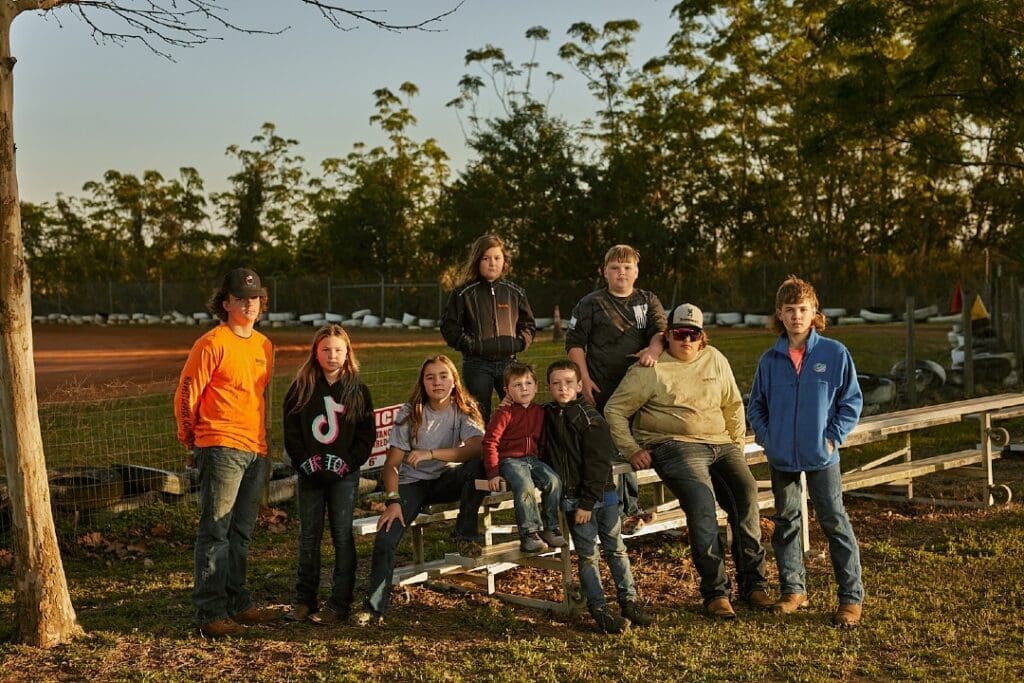
Founded in 2004, the Mower-Plex is maintained entirely by volunteers from NASGRASS, which is a registered nonprofit. When 48-year-old Pyburn took over the club 12 years ago, only about six mowers showed up each month to race. Now they have at least 45. With Pyburn at the helm, members started to invest more time and money into the appearance of the Mower-Plex, and as a result, membership grew. The club relies on spectator tickets, $35 annual membership dues and the generosity of the community to keep mowing growing, but the pandemic has left the Mower-Plex strapped for cash. With smaller crowds, fewer racers and no opening night revenue thanks to coronavirus shutdowns, the club is faced with a precarious path forward.
“We really don’t have the money for nationals,” Pyburn tells the drivers plainly. Lawn mower racing isn’t exactly a pricey pastime, but it also isn’t a very lucrative pursuit. On a good year, NASGRASS has a couple hundred bucks in the bank to kick off the season, usually thanks to an exciting opening night in October that draws a crowd of about 150 spectators. With no October race in 2020, the club hasn’t been so lucky.
“This year we were dead broke,” Pyburn says later.
At the meeting, he puts the club mower up for sale. It’s the last machine ever built by Pat Sullivan, sod-slinging royalty, and Pyburn hopes they can get $500 for it to cover the cost of trophies for nationals.
“We’re just trying to cross our fingers in the hopes that something comes along,” he says. “If we can finish off the season, we’ll be OK.”
Rubbing Ain’t Racing
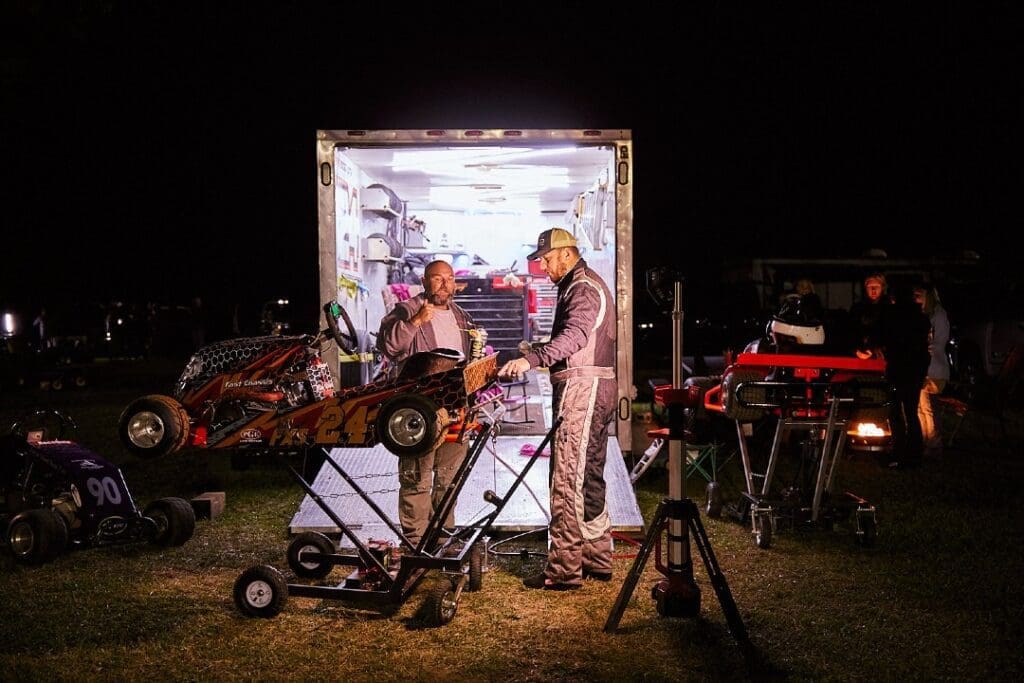
Pyburn rattles off the rest of his agenda: the track’s environmental protection plan, stay away from the lamp being held up by hose clamps and remember not to drive 60 miles per hour through the pit.
Finally, “Did you all read the rules for this season?” Pyburn asks. Their heads bob with an even number of nods and shakes. “Read it,” he says.
Despite the impression it might give off, this isn’t a redneck rodeo where anything goes. There are rules, 29 pages worth, covering everything from the technical specificities of each mower class to who’s responsible for the behavior of wives and mother-in-laws in the pit—Pyburn assures me this wasn’t inspired by true events.
The No. 1 rule of lawn mower racing? No bumping. Rubbing might be racing when it’s stock cars but on lawn mowers, two tires touching can send these mowchines end over end. That’s exactly what happened to Randy Gandy, Wallace says. Randy was coming down the backstretch, rubbed tires with another racer and sent his mower flying.
“I think it spun two or three times in the air,” Wallace recalls, right into the fence.
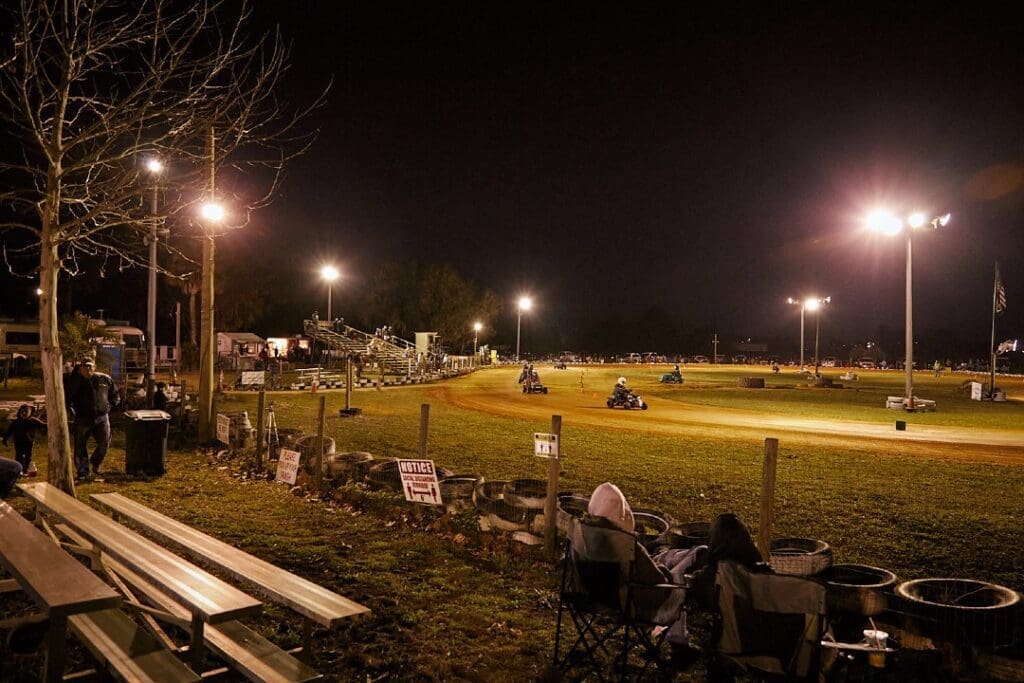
The rules aren’t just about racing, either; most of the pages are dedicated to the specific requirements for each of the nine lawn mower classes (plus one go-kart class). It’s not as simple as picking up a John Deere from your local Home Depot and removing the blades. These contraptions are DIY, and the rules spell out everything from tire size and what engine modifications can be made to a ban on handlebars so drivers don’t get skewered in the case of a rollover. New requirements are added all the time. When one of the Wallace family friends, Becky, got her throttle stuck on the straightaway, she crashed into the tires cushioning the chain-link.
“Flew up and over the fence and got beat up pretty bad,” Wallace says. “There was a new rule made in her honor: double springs on the carburetors.”
Pyburn wraps the driver’s meeting and asks, “Is anybody mad at me about something? Y’all seem pretty grumpy.”
“It’s cold!” one yells.
“I’ll let you know after the race,” quips Michael Graves, a 48-year-old racer from Sebring. For nine years, Graves has been driving up to Avon Park every month to see just how fast he can push his mower.
“I was born in a racing family,” he says. His father raced cars for 30 odd years. “It’s just in my blood.” After his father died in 1998, Graves’ hobby took on a new meaning. He painted his mower purple, the same color his dad’s cars used to be, and adopted his number: 41x. Graves has been running down a first place win since the day he climbed on a mower, and he finally clinched it last month.
“Nine years I’ve been chasing it,” he says, a grin spreading across his face like he’s still standing on the podium. “I won a couple heat races, but to win a feature is like winning the lottery.”
Mini Mow Nation

Every race begins ceremoniously with the participants lining up on the track for the pledge of allegiance and national anthem. Then, they all bow their heads for the blessing. They ask God to watch over them, they pray for safety and give thanks for the old tires that cushion the fence in case the prayers don’t stick. The night is divided in half. First, each class competes in a 10-lap heat race. Then, they move into the features, a series of 20-lap matchups. The competition typically starts with the slowest class, Mini Mow, and finishes with the big guns, the FXTs, which can clock speeds of 100 miles per hour when given the room to fly.
Although its top speed is 21 miles per hour, the Mini Mow heat still puts on a show. There’s something about watching 6-year-olds drifting on a mower that gets the crowd going. “It’s hilarious because it’s usually one of the best races of the night,” Pyburn says. The Mini Mow class includes children ages 6 to 9, but on nights like these where there’s only one contender, it’s combined with the Mini Mow Pro group, a class of racers between 9 and 12.
The kids don’t seem to mind that they’re only racing for a 50-cent medal, to them, it’s all about securing the ultimate third-grade bragging rights. Isabella Gavagni, an 8-year-old from Lake Placid, joined Mini Mow because she didn’t want to watch her cousin, Tyler Wallace, have all the fun. She wants to move to New York City where they have all the best pastries and everything shines, but for now, she’ll settle for the portable stadium lights that illuminate the Mower-Plex track.
Isabella says it’s not the actual racing that proves most difficult, it’s trying to remember what all the flags mean. Green means full speed ahead. Yellow and white mean you’re halfway through the race. Black is really bad, she says. Isabella pauses, whispering to Tyler for the rest of the answers. Her first time on a lawn mower wasn’t scary, she says, just confusing.
“I forgot all the flags that time. So I watched everybody else go, and I followed them.” Her 8-year-old cousin Tyler takes things a little more seriously.
“I was actually the first person to race in my family,” he says proudly. Now his dad, his Uncle Tony and his cousins have all joined in. If it has wheels, Tyler likes to ride it—four wheelers, go-karts, Razor scooters—but he admits his first time on a lawn mower was a little different.
“It was fun but also a little scary,” he says. Tyler doesn’t get the pre-race jitters anymore. He’s been doing this for two whole years. He’ll even divulge his strategy if you ask. Stay on the inside and hold your line so the other kids can’t sneak past, he says. As he comes up on the turns, he slows down just a tad so he doesn’t slide.
“Sometimes you can get distracted by the people, and you can get nervous and spin out,” he says. “Not to me, but to other people.” Despite his laser focus, 12-year-old Kaitlyn Chancey is still the one to beat, he says. Tyler isn’t confident that tonight will be any different. Everyone always races hard.
The Red Rocket
The stands are sparse but that’s because most people have opted to back their tailgates up to the fence that circles the track. There, they can watch the racers as they round the backstretch and have their bonfires going, too. The smell of smoke mingles with the stench of diesel fumes and chewing tobacco.
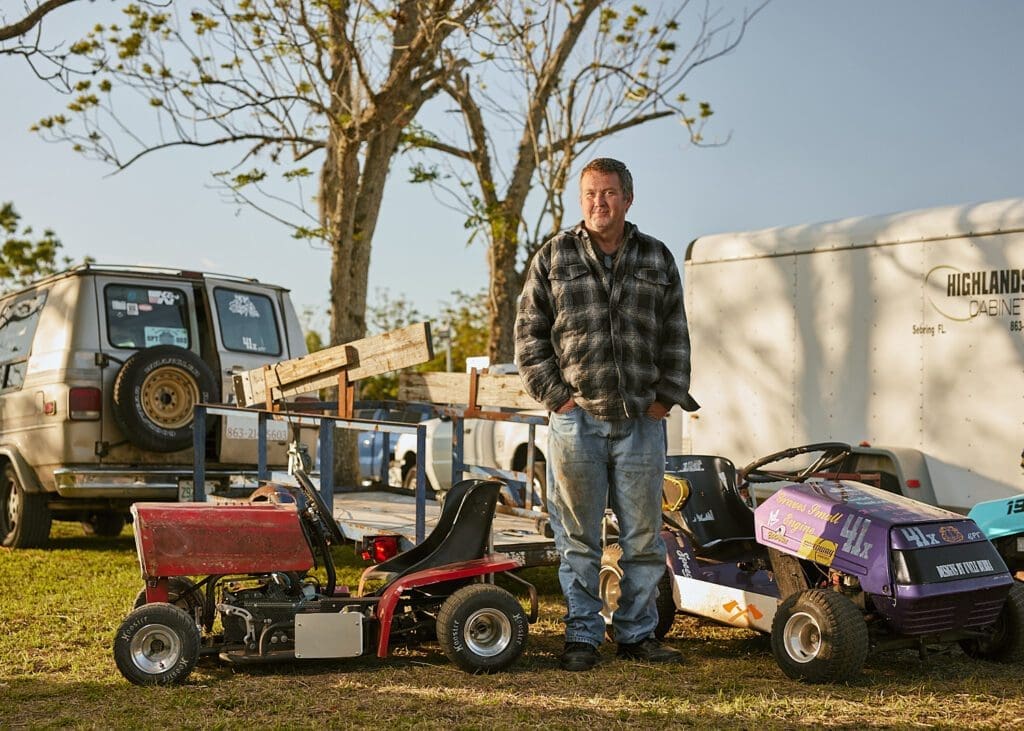
The Mini Mow group rolls onto the track for their heat race, lining up in the random order they drew. When the green flag waves, tires squeal as their engines rev to life. Kaitlyn takes an early lead. Tyler tries to slip around her on the turns but can’t quite muster up the speed to overtake her. He walks away with a second-place finish.
The GP Twins, Michael Graves’ class, is also known for theatrics. These machines crank out an average 25 horsepower and hit speeds of 32 miles per hour. This is the first class where you’ll start to feel your wheels slide if you hit the turns too fast, Pyburn says.
Pyburn is the one to beat, Graves says, and most everyone would probably agree. He’s been racing since he was 11 years old. His parents said he could pick it up as a hobby if he scraped up enough money to buy his first car. Pyburn dog sat and mowed grass for two summers and scored his first set of wheels for $500. For 20 years he raced everything from bomber cars with all the windows knocked out to 600 horsepower stock cars, until he found lawn mower racing 13 years ago.
“I’ve got a need for speed,” he says. “Stock cars were great, they were just so expensive, and this still gives me the adrenaline rush.” As an ode to his stock car past, Pyburn prefers to race red mowers, the color of his very first race car, and he always wears bright red sneakers to match. They call him the Red Rocket.
Graves may not have decades of auto racing under his belt but he’s already proven he can hang with the best, and he’s hoping for a repeat of last month’s win. Unfortunately, things go awry quickly. Another mower rides too close and jumps up on his back tires, somewhere along the way Graves gets an orange cone stuck in his mower. He doesn’t get much further when his engine peters out. The rest of the racers slow as a track official walks over and yanks the cone out from his chassis, and the engine sputters back to life. At least he isn’t forced to retreat to the pit, where everyone turns to watch you bump back to your trailer while your machine spits smoke.
But Graves isn’t able to recover. He doesn’t place in his heat race. Pyburn on the other hand, runs away with the gold. In the feature race, Graves places sixth. Pyburn wins again.
Graves can’t hide his disappointment. The high from his previous month’s victory completely vanished. During intermission he admits he’s “upset.” Patty Loveless croons about a lying, cheating, two-timing heart over the loudspeakers.
Adrenaline Junkies

Ask any of these racers why they keep flinging mowers around a tight oval track and they’ll all tell you the same thing: the adrenaline is unbeatable. Bill Veal was hooked the moment he carved his first set of tire tracks into the clay.
“I ride motorcycles. I’ve bungee jumped. I’ve hunted. I always thought hunting was the biggest adrenaline rush,” he says. “This is a bigger adrenaline rush.”
And apparently there’s a kinship in knowing you all could possibly hurl yourselves off of a John Deere.
“I can’t stress enough how tight knit of a group it is,” Pyburn says. Outside of race weekends they travel to RV shows together and go camping in Astor. You won’t find the same sort of cliques you do among soccer moms or little league kids, says Stacy Wallace, 50, Brian’s wife and a lawn mower racing powerhouse. There’s no air of superiority among this crowd. She joined the eccentric sport as a way to bond with her two sons. They hunt and fish with their dad, and race lawn mowers with mom.
“It’s friends that become family,” she says. “This right here? I wouldn’t change it for anything.”
It’s hard to tell whether the kids prefer racing or running around in the pit together between their heats. Sure, a little smack talk is exchanged but all is quickly forgotten when it comes time to start a game of tag. In fact, Tyler Wallace (no relation to Stacy and Brian Wallace) says his only pre-race ritual is playing with his friends—oh, and putting on his helmet. Maybe it’s the halftime game of chase the tire that puts him in the right headspace for his feature race.
“It’s friends that become family. This right here? I wouldn’t change it for anything.
— Stacy Wallace
He isn’t discouraged by his second-place finish earlier in the night. The feature race starts out much the same way: Kaitlyn out in front, and Tyler creeping up behind her, hoping he can squeeze around, or better yet, wait until she makes a mistake. He gets his chance when she spins out about halfway through trying to avoid another mower. While Kaitlyn takes a moment to right herself, Tyler doesn’t miss a beat. He slides around her spinning machine and into first, holding his line until he passes the checkered flag.
When he cruises back into the pit, he’s greeted with fist bumps and slaps on the back. Tyler pulls off his helmet to reveal an ear-to-ear smile, holding his plastic first-place medal high.

“Did you see? Did you see?” He says, running up to the spectators on the picnic bench, his excitement infectious. He requests a picture in front of the “NASGRASS Feature Winner” sign, and then another when he realizes his medal is backward. His mother beams from the sidelines, even though Tyler claims she doesn’t like to watch him race. “My mom thinks it’s too scary,” he says. He scampers back over to find his friends for another game of tag. It doesn’t seem the win has gone to his head.
The night is a heartwarming mixture of camaraderie, competitiveness and flat out crazy. Sometimes the drivers walk away feeling like Graves: defeated and disappointed, wondering why they spend hours tinkering with a mower only to have it quit on lap six. But for the night’s winners, like Tyler, it’s the sod-slinging glory that keeps them returning to a track nearly lost in obscurity, even before the pandemic. And while the grass-cutting machines at the center of the race might surprise many an outsider, one thing’s for sure: never underestimate a man and his mower.





